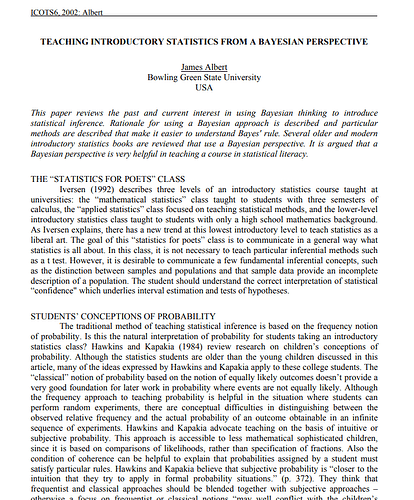I could not agree more. The BEST approach, unlike peeking at the data to see which assumptions of a t-test are somewhat likely to hold then choosing an equal-variance vs. an unequal-variance t-test, is honest. The frequentist approach, when you don’t know whether variances are equal or that the distribution is Gaussian, results in inaccurate p-values and confidence limits. The Bayesian approach results in accurate credible intervals and posterior probabilities that take into account that we don’t know if the variances are equal or that the data are Gaussian.
What a great topic. Even reading graphs and medical tests are a challenge for some physicians. They seem to echo what is taught to them by representatives of medical products. That is the statistics that they are apprised of.
Probability doesn’t exist. In the case of patients they can rightly wonder whether someone else with a similar diagnosis, actually has similar problems in their body, and whether their body will deal with it similarly.
I can come up with a number of different “probabilities” that I may claim apply to a person, depending on how I categorise them.
Probability—in the classical and correct sense in which Boltzmann used it with 10^23 inert bodies following physics, to infer limiting cases which will definitely happen—might happen in medicine if we are talking about immune cells sometimes killing or sometimes failing to kill an invader. But overall “survival probabilities”? Those don’t exist. We may have observed 500/1000 or 10/1000 survival rates for all of the cases we know about, but this patient may be part of a subclass with very different survival odds than the general case. And I think that’s precisely what a patient would be wondering if they “mis-understand” the definition of probability. Even if they don’t read papers or books that use the phrase “hidden variables”.
Ian Hacking, and pretty much everyone writing in philosophy of probability, distinguishes “epistemic uncertainty” as one philosophical type of probability. But what goes into probability numbers that are stated to patients includes statisticians making arbitrary choices + facts about the experiment that aren’t told to the patient — and what doesn’t go along with that probability number is how good the probability number is. (Actually it may in the form of the doctor telling the patient, “We don’t know much about your disease because it’s so rare”. Does that count as a doc “not understanding probability”?)
You could teach probability using dice (pick one with uneven sides, say 7/8 for the most likely side, so that things feel “normal, with exceptions”) — but not only is the body way more complicated, and a disease has way more measurable steps than a die roll,— there are so many sources of error and choice, that dice aren’t a good model for the kind of probability that patients face.
If we are talking about diagnosis, there are always so many facts about the patient’s body and the patient’s disease that we don’t know, that “the” number we give them might be wildly different than what the survival odds might be with complete knowledge.
No discussion about probability is complete without mentioning subjective probability and degree of belief, which are just as valid as frequency-based probabilities.
